Chinese MQ668 Watch Phone Review
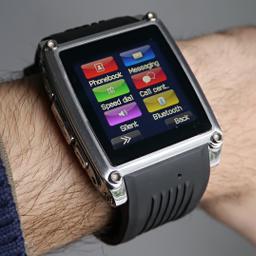
Back in 2008, I discovered by chance that wearable cellular phones, or watch phones, actually exist. I bought one on eBay, the Nova N800, as an experiment: check out my review. Despite my expectations it turned out surprisingly practical, to the degree that it became my main cell phone. A good two years later, around the middle of 2010, I switched to a newer model called ‘S9110’ (not Samsung's, but a Chinese model of vaguely similar design). I used it until it started to show obvious signs of wear and tear about two and a half years later. Then I started looking for a successor, and after quite a few troubles I ended up with a model called the ‘MQ668’.
Chinese Watch Phone Roulette
Contrary to the two previous reviews (N800, S9110), I will keep this one short. This review will be more like an illustration of the issues described in a lengthy article I recently wrote where I discuss the current state of watch phones, with emphasis on Chinese models in particular. The article also explains the difference between what I call a watch phone and a smartwatch.
At the time of this writing, practically all watch phones are designed in China (as opposed to merely manufactured like pretty much anything nowadays). Some small Western companies (like Burg and sWaP) have started to design their own, but they are similar to the Chinese models. There are a few Kickstarter projects that aim to go beyond the current mainstream watch phone platform, but none of them have produced what I consider a usable true watch phone as of yet.
Two main problems with Chinese watch phones: first, they are all designed around the same MediaTek (MTK) platform which has barely changed over the last six years from an end-user viewpoint. With the exception of the only Android-based model ‘Z1’, the feature set is prehistoric, comparable to a phone from around 2003. Second, many of the companies that design the phones seem to buy a development kit from Mediatek and design something around it without entirely knowing what they are doing. The result is often a product full of bugs and flaws, sometimes to the degree that it is unusable. There is no support, there are no updates. The only thing one can do when buying an unusable Chinese watch phone, is send it back for a refund. This is why in my watch phone article, I compare ordering a Chinese watch phone to playing a game of roulette. I was well aware of this when ordering the successor for my S9110, but it proved worse than I expected. I will come back to this later on.
Someone seems to sell the MQ668 under the name ‘SmartInfoTec’. I cannot tell whether this is merely the act of slapping a brand name onto a generic Chinese product, or they actually do some quality control and bug fixing. From the rest of this review you shall see why I hope they do more than merely reselling the raw product…
What's in the Box
As you can read further on, eventually I ordered an MQ668 directly from a Chinese seller. The transaction was smooth and the seller was a lot more helpful than the two European sellers I tried first. I opted for express courier instead of the humongously slow air mail. Despite creative attempts by the seller to fool customs, I had to pay import taxes. Overall I paid less than for my previous models however. The package contained the following:
- The watch phone, obviously
- A spare battery
- A wall charger (which offers a USB power socket).
- A wired headset
- A manual in not too horrible English, specifically written for this model. This is unusual: most watch phones come with a generic, barely useful manual in horrible Engrish.
No Bluetooth headset this time, not that I care because it would have been crappy anyway. My Samsung headset works perfectly with the MQ668.
An important note is that I specifically asked the seller to ship me a model with Chinese language support (which is useful for me). Although this should not influence the overall contents and setup of the interface, it could have some major implications. In this case it caused Java support to be replaced with something specific for the Chinese market.
The Good
In my two previous watch phone reviews, I ended with a list of good and bad points. This time, I kick off with it. First, the good.
- The design is quite nice. Although the body is plastic, it all fits tightly together. I like the looks a lot more than of the Nova N800 and S9110.
- The dimensions are: 44mm wide, 55mm tall (about 66mm with the band), and 14.5mm thick. Despite the fact that this is 1.5mm thicker than the S9110, it can be more easily worn under a shirt thanks to the less tall shape.
- The screen is awesome. It is the same type of screen as in the iPod Nano 6th generation. This screen has gradually become the new standard for watch phone screens since it was introduced in the TW810 model. The screen has a high resolution (240×240 pixels), and can be pretty bright. It is readable in direct sunlight, albeit not very easily.
- The touch screen is very responsive, a clear improvement over the S9110. As with almost all watch phones it is resistive. In my opinion this makes more sense than capacitive for such a small screen, because it does allow using a stylus or your fingernails for more accurate control. Most of the interface is designed to be operable without a stylus, but typing can be done much more efficiently with something more refined than a meaty finger.
- It is very light: only 53.6 grams to be exact.
- A very good loudspeaker that puts out an impressive sound volume for its size. It can go quite loud without distortion, an enormous improvement over the poor speaker in the S9110.
- The battery is 450mAh and this corresponds with its physical size (very often, the indicated capacity is an exaggerated lie). With non-intensive usage, the phone can last about 120 hours which is not bad at all. The battery does not charge at a ridiculously fast rate that causes it to heat up and wear out prematurely, I expect it to last very long.
- Bluetooth works very well, and bluetooth file transfer is about three times faster than on the previous watch phones I've had.
-
Although the camera is still only 640x480 (it pretends to be 1.2MPixel but this is interpolated), it takes sharp photos, the best I have seen in a watch phone yet. The thumbnail to the right links to a full-size photo taken with the MQ668. The camera is mounted at the right edge, which makes it much more useful to me than a front-facing camera.
- There is a full-size on-screen QWERTY keyboard, not a clumsy multitap like on some other models. There is a big minus about this however, see below.
- The SMS messaging system is very good. It shows previews of the messages in the mailboxes, and it stores all messages with time stamps. By far the best I have seen on a watch phone.
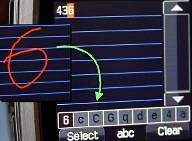 It has pretty decent handwriting recognition: it is now finally possible to write both uppercase, lowercase, and numbers without having to switch input modes. Or, to insert a number quickly without having to leave the ABC keyboard. This makes handwriting much more usable than on my previous watch phones.
It has pretty decent handwriting recognition: it is now finally possible to write both uppercase, lowercase, and numbers without having to switch input modes. Or, to insert a number quickly without having to leave the ABC keyboard. This makes handwriting much more usable than on my previous watch phones.- The clock wallpaper shows the day of the month.
- This MQ668 has the good old manual configuration for the data account (APN etc). This is becoming increasingly rare. There is an alarming trend of recent watch phones only offering an ‘automatic’ configuration that does not work with many cell phone operators. Eventually I will just have to stop buying these phones altogether if they all switch to this dumbed-down system. If I cannot configure internet on a phone, it is a useless piece of junk to me.
The Bad
If the above list seems to give a good impression, make sure to first read the following before considering to buy one of these. Merely looking at the length of the list should already give an indication…
Every bad point that can somehow be remedied has a link [Hackable] next to it that points to a description of how it can be hacked. Mind that some of these hacks are so difficult that they are only of theoretical interest for the average consumer.
- The USB plug is not micro-USB but some proprietary variation on the plug used for many older Chinese cell phones. It is the same shape as for the S9110/F6, but the pinout is different.
- Outgoing sound quality is truly horrible at times. This appears random and I suspect it is worst when there is no cell phone antenna nearby and the phone has to boost its outgoing signal. The person at the other end of the line hears the kind of buzzing noise one can hear when holding a cell phone near an audio amplifier. [Hackable]
- Even when there is no horrible buzzing, the microphone seems of too low sensitivity and the people at the other end still have trouble understanding me. [Hackable]
- Sound volumes are all messed up. While calling, there is only a choice between very loud and eardrum-shattering loud. When setting ringtone volume, the preview is not played at the same level as the actual ringtone. [Hackable, partially]
- The on-screen keyboard is tiny and is the same awful low-contrast one as on the S9110. It is barely usable. [Hackable]
- Not even remotely water-resistant: there are obvious gaps where water could enter. I would hesitate to wear it in a situation where I might sweat a lot, because sweat could enter the case from the underside.
- The phone is not detachable from its wristband (as you can read in my watch phone article, I consider this a big deal). This would not have been that bad if the band would not be fitted with a cumbersome tang buckle. [Hackable]
- The USB/charging port cover is very sloppy and has a tendency to open and flap around spontaneously. [Hackable]
- The address book is very poor: only one name, one number, a picture, and a ringtone can be set per entry. The length of the names is limited to a measly 15 characters. Hey, 1999 called, they want their address book back.
- There is no automatic time update at all. Time must be set manually, and the clock will stop whenever the battery is removed. Time is not shown anywhere except on the screensaver and the main screen. Together with the two-second delay to wake up the screen, this makes it a very lousy watch. As icing on the cake, the analog clock display will be completely wrong during a few specific time periods each day.
- The interface uses a ridiculously thick scroll bar instead of allowing to swipe like any modern phone interface. This scroll bar wastes 20% of the screen area. In the web browser it is even worse.
- There is a built-in web browser, but it is riddled with problems:
- It is slow because the phone still does not offer anything better than prehistoric GPRS.
- It does not present itself as a mobile browser. This means websites will try to feed it full-size pages, which will most often cause an “out of memory” error, and if they do load they are unusable due to the tiny screen. [Hackable]
- Even small pages specifically formatted for a 2003-era mobile phone browser will sometimes trigger an “out of memory” error.
- It has no support for PNG images. This is baffling, many mobile sites use this format.
- Scroll bars are ridiculously thick and waste an unacceptable amount of screen area. [Hackable, in a very limited manner]
- ‘Select’ elements in web forms do not work. They appear to work, but the selected options are not sent to the server.
- The browser seems to have a memory leak that will not only prevent pages from being loaded after a while, it will also break other parts in the phone interface until the phone is rebooted.
- There are two hardcoded bookmarks for Yahoo and Sina that cannot be modified or erased. [Hackable]
- There is no stopwatch, and not even a calculator. Really? Those are features that could be found on even the most primitive of cell phones back in the 20th century. Especially the lack of a calculator app on a wearable computer is pretty much infuriating.
- When the screen has gone dark due to power-saving mode, touching it will instantly trigger a ‘click’ in the interface at the touched location. In other words, you could easily call someone unintendedly, or erase something without knowing it. Extremely annoying. A workaround that mostly works is to wake the screen by dragging across it.
- There is no way to completely lock the display. Touching it will almost always wake it up. This is more convenient than having to push one of the hardware buttons, but it should be possible to lock the screen in case it could rub against clothing constantly, which would drain the battery.
- The battery indicator is inaccurate. Although it has six segments, it will jump from 5 to 2 bars and stay at 2 bars for a very long time. [Hackable]
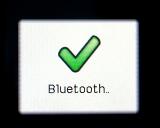 Most of the system dialog boxes only show the first word of the message, the rest is cut off (e.g. enabling or disabling Bluetooth will both show a message “Bluetooth…”). I know what causes this: the Chinese designers never considered that English text requires many more characters than Chinese.
Most of the system dialog boxes only show the first word of the message, the rest is cut off (e.g. enabling or disabling Bluetooth will both show a message “Bluetooth…”). I know what causes this: the Chinese designers never considered that English text requires many more characters than Chinese.- No preview of photos in the interface. Matrix browsing is useless because there is no way of scrolling inside it.
- The camera is at the right side of the phone but the preview is shown upright. In other words it is rotated 90° relative to what one would expect. This makes taking photos extremely awkward because movements do not correspond with what is seen on the screen.
- The interface will often only show two lines (e.g. files, addresses) where there would have been enough room for three lines.
- No Java support, although most of these models offer it. This is most likely due to the Chinese firmware, which has a built-in QQ client instead. To me this is not such a big deal, because the number of usable Java apps on these watch phones is extremely limited anyway. Anyhow, if you want to order a watch phone and be sure it has Java, demand confirmation with the seller.
- After a few months of usage, the plastic casing started to show little cracks at two spots around the place where the strap is attached. After six months, one of those cracks has gone all the way through. The fact that the phone is not falling apart and still seems solid, is probably thanks to the screwed-on piece of aluminium decoration at the top.
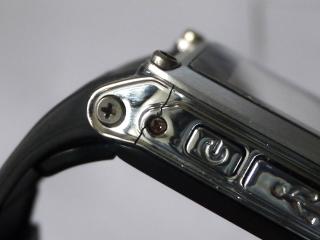
The Ugly: Hacks
I created a general page that explains how to modify some aspects of the MT6253 platform this phone is based on. Therefore I will keep the description of those hacks short and refer to that page for more details.
Microphone buzzing sound
The main reason why the microphone picks up so much noise is that it is placed pretty much inside the GSM antenna. Anyone with basic electronics skills could see that this is asking for trouble. Even if the microphone itself would not be influenced by the radio waves, its relatively long wires act as excellent antennas. Even though in theory the high-frequency GSM signal could not influence the audio range, non-linearities will cause the typical buzzing sound one often hears when holding a cell phone nearby cheap PC speakers.
The fix I did is straightforward: move the microphone and its wiring away from the antenna. The mic is now also perpendicular to the antenna instead of parallel with it, which could help as well. This could be done without soldering, the wires were long enough. I also twisted the wires to make them less of a huge antenna loop. Luckily, there was just enough room in the side of the phone to put the mic, drilling a tiny hole was all that remained. The result is crystal-clear sound with no buzzing.
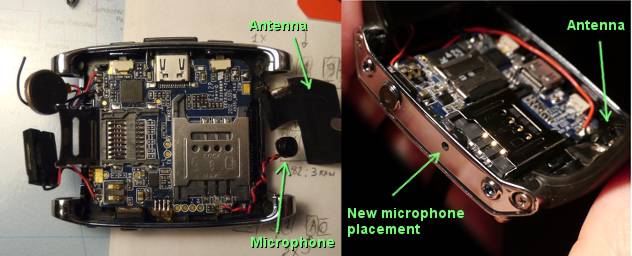
Microphone sensitivity
Many people report too low microphone sensitivity on their watch phones. On my S9110 I had to talk really loud to make myself be heard, and on this MQ668 it is not much better. With other models, people on the other side hear an echo of themselves. The reason for both issues is poor echo cancellation (AEC). The older MT6225-based phones had not too great an AEC algorithm, and it had a particularly hard time with the small size of watch phones combined with poor quality speakers. A cheap workaround for this is to turn down the mic sensitivity, and many Chinese phone manufacturers seem to do this by default, to err on the safe side.
The MQ668 however has an excellent loudspeaker and the AEC in its MT6253 SoC seems to be much improved compared to the 6225. Hence there is no need for the traditional workaround. My fix was turning up microphone sensitivity to the max. Together with the previous hack this has changed the phone from nearly unusable to perfectly usable.
Audio volumes
The people who configured this phone must have had no idea what they were doing when they set up the volume levels. Most are way too loud. I fixed this by setting the gains to a much wider range of reasonable values. It is still not perfect, for instance there is almost no difference between hand-held and hands-free mode, and when previewing ringtones the levels do not correspond to the actual ring volume. But now I can at least make a call without going deaf or everyone around me hearing the entire conversation.
On-screen keyboard
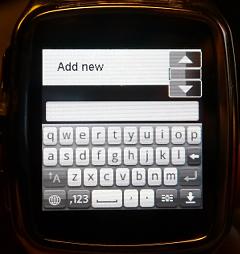
Many new models of watch phones similar to the TW810 have a much improved iPhone-style keyboard, as can be seen in the photo at the left (this was the second TW810 I tried). To my taste this keyboard is even a tad too big, it takes up more than half the screen, but it is almost usable with plain fingertips. Big was my disappointment when I discovered that the MQ668 has almost exactly the same keyboard as my S9110.
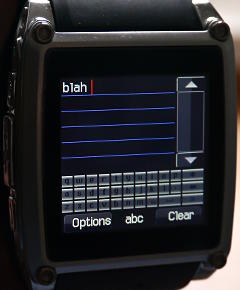
I can live with the tiny size of the keys, but using dark symbols on a dark gray background is ridiculous. It is incomprehensible how anyone can design something stupid like this. To make things worse, the background appears even darker when holding the phone in the most comfortable position to enter text, as shown in the photo. I thought this would be an easy fix: just apply the same strategy as with the S9110. Boy, was I wrong. In the end I pulled it off but this hack has taken so much time that I swear this is the last Chinese phone I will hack so thoroughly. Details are in the Chinese phone hacking page. To give you a taste: I had to dig through binary junk for days, and reverse engineer a 4-bit RLE image format from scratch. Yay.
The upside is, once I started hacking I went as far as also reverse engineering the keyboard lay-outs, and I pretty much redesigned the keyboards from scratch. The result is a massive improvement in usability. Now the keyboard is as usable as the new-style TW810 keyboard, which is probably as good as a full-size keyboard will ever get on a screen this small. (Of couse, a radical re-thinking of text input for tiny devices like these could result in a way better interface.) Again, details of this hack can be found on the hacking page, but I can tell you in advance it is not a walk in the park.
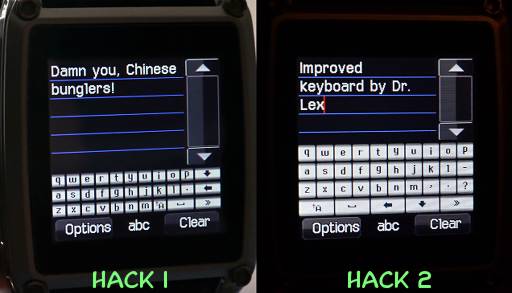
Easy to open clasp
My very first watch phone, the Nova N800, could be detached from its wrist band. This may be the only reason why I became enthousiastic about watch phones. The Nova could transform between a wristwatch and a tiny handheld phone in one second. When I looked for a new watch phone to buy, I was disappointed to discover that there were no new models with this feature. I settled for a folding clasp on the S9110, allowing to remove the phone from my wrist in reasonable time. It was considerably more cumbersome than instantly clicking the phone from its band.
You have no idea how practical a detachable watch phone is until you have tried both this system and a non-detachable phone. I cannot understand how manufacturers cannot see that the general public does not want a telephone that is semi-permanently strapped to their wrist. No matter how cool Knight Rider was, nobody wants to make phone calls by screaming to their arm. Nobody wants to be forced to use a headset. Look at the sketches of my ideal watch phone and you'll see what I mean.
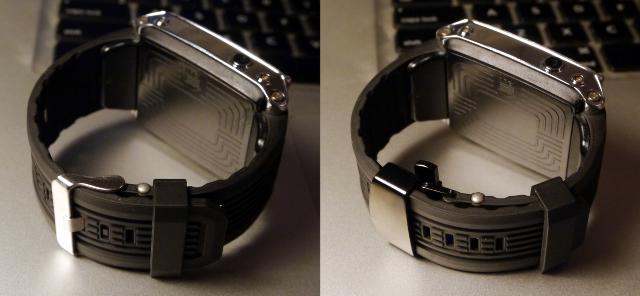
The MQ668 also has a stupid tang buckle and it is impossible to replace the custom band because it is an essential part of the whole construction. Luckily, so-called deployment clasps exist: foldable clasps that can be fitted to an existing watch band. It was difficult to find one for the 26mm width of the band, but I found one at Watch Band Center. I fixed the movable ‘ring’ to the strap using needles to make everything snug.
Loose USB port cover
This is a rather easy fix: find two very thin pieces of rubber (e.g. cut a bicycle inner tube) and glue them to the little protruding part of the port cover.
Browser user-agent
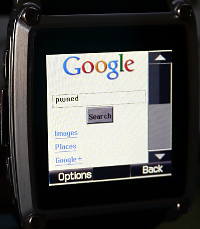
I explained this issue in detail on the S9110 review page. In a nutshell: by making the phone identify itself as a well-known model with a similar screen size and memory capabilities, many websites (most importantly, Google) will reformat their pages to fit on the tiny screen and not choke the browser. This makes internet quite usable, although various bugs will still break some websites. On the S9110 it was easy to make the browser pretend to be a SonyEriccson W700i or K800i (once the Engineer mode code was known). The MQ668 has no option to change the user-agent however. The only way is to hack the string in the firmware itself, not something for the faint of heart. I used this HTTP_USER_AGENT string:
“SonyEricssonK700i/R2AG SEMC-Browser/4.0.3 Profile/MIDP-1.0 MIDP-2.0 Configuration/CLDC-1.1”.
For sports I also set the correct X_HTTP_WAP_PROFILE header although almost no website honours it:
“http://wap.sonyericsson.com/UAprof/K700iR201.xml”.
WAP bookmarks
This is a relatively easy fix once you know how to mount the hidden FAT partition as explained on the hacking webpage. The bookmarks are simple files stored in the folder ‘@vbookmarks’.
Avoiding the stupid horizontal scroll bar
Take a look at this photo:

Would you dare sell a device that handles scrolling this way? Massive scroll bars that reduce the available viewport even further in case a page is too large? A good 33% of the viewing area is wasted when the two bars are visible. I hope the person who designed this always wears a paper bag over his head, because he should be too ashamed to show his face. But wait, it can get worse. This was how it looked on the first TW810 I tried:
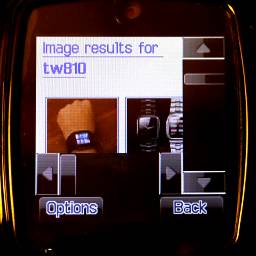
The scroll bars are fancier, and bigger. They waste a full 50% of screen real estate. How could anyone even look at this and not think it is hideous and preposterous? The person responsible should wear a plastic bag instead — without breathing holes obviously. Even despite their huge size those scroll bars are not very easy to use. Swiping would have been easier and not waste any of the already scarce pixels on such a small display!
There is no tractable way to make the bars smaller, but there is a way to avoid the horizontal scroll bar on Google's WAP pages. I will save you the details because I realise I am the only person crazy enough to do this hack. Everyone else will use Opera Mini instead of the crappy (albeit much faster booting) built-in browser. The hack is explained on my MTK phone hacking page for those interested. It involves tweaking the browser's built-in CSS defaults, which must be done in the binary lump of firmware. Yes, the browser does support CSS in a pretty decent manner, one of its only redeeming qualities.
Battery indicator
The battery levels are editable in the Engineering menu, accessible on this phone through the code *#503#. The strange behaviour of the indicator was because two values were swapped in the look-up table. Even after fixing this, the indicator was still not representative for the remaining capacity. To improve it, I steadily drained the battery while measuring the voltage. The resulting discharge curve allowed me to configure the indicator levels such that they give a good idea of remaining time. One caveat is that although the indicator has 6 bars, the level with 3 bars does not exist, so I accounted for this.
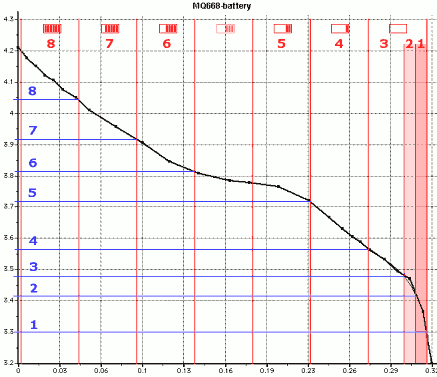
Connector pin-out
Just for reference, this is the pinout for this particular phone. The plug shape is the same 12-pin connector as many other ‘China phones’ like the i9. Mind that thanks to the whims of the Chinese manufacturers, it is entirely possible that the pinout will be different on your particular MQ668 even if it looks identical to the one in my photos.

- Pin 1: USB 5V
- Pin 2: GND
- Pin 3: ?
- Pin 4: one of the headset pins
- Pins 5-6: ?
- Pin 7: USB D+ (green wire)
- Pin 8: USB D- (white wire)
- Pin 9: serial Tx (signal coming out of phone)
- Pin 10: serial Rx (signal going into phone)
- Pins 11-12: ?
What to Expect When Trying to Buy a Watch Phone Anno 2013
Either the market for watch phones has in the past few years severely degraded to a cesspool of sellers trying to rip off customers, or I simply had a lot of luck with the first two models I bought. I will save you the fine details but still give an idea of my experience in obtaining this MQ668.
In a nutshell, I first tried two copies of the ‘TW810’ model. I specifically ordered from European sellers in the hopes that they would do at least a little quality control on what they resell, and also that it would be easier to get my money back if things went wrong. Not really. First of all, both sellers did not really know what they were selling. Questions about the features of the phones remained largely unanswered, so I had to assume the lists of specifications were correct. They were not.
The first model had hardware defects in its touchscreen and bluetooth. The refund went OK. The second model did not have the features advertised on its eBay page, and like the first one, people at the other side of the line heard my voice through a loud buzzing noise. For some reason the seller seemed to be pissed off when I sent the thing back following eBay's protocols to the letter, and it took months before he finally refunded my money. Hey buddy, if you do not like eBay's way of working then do not sell on it, mmkay?
Eventually I went back to the same source as where I bought my first two watch phones: directly in Hong Kong or China. This went incredibly smooth and not only did this seller actually know what he was selling, he even did the effort to customise the product to my demands. The only disadvantage is that I had to pay considerable additional import taxes. There is one thing to be said, I have a solid impression that Chinese merchants are much more honest and take pride in providing a good shopping experience. Is anyone wondering why their economy is booming? I do not. Now if only they would learn how to properly design stuff…
The Bottom Line
The MQ668 is a perfect illustration of the current state of watch phones: yet another variation on a stagnant more than five-year-old platform that is completely closed and very difficult to modify. The product is full of horrible bugs and dubious design decisions, and has some essential features removed to honour my empirical law of preservation of suckiness. The MQ668 is the third watch phone based on the TW810-style platform I tried. Despite the fact that all three had different hardware, they had similar problems. The most obvious was that all had the same horrible buzzing sound during calls, making these phones nearly unusable to the average consumer who does not want to do the crazy hack I did to fix this problem. This makes me believe that nearly all current Chinese watch phone models have this problem.
Although the phone is quite usable now that I spent a lot of my sweet time hacking it, in its original state it was nearly unusable. I do not recommend buying it, unless you are an electronics ninja. Moreover, thanks to the fact that multiple Chinese companies could be making variations on this model, there is no telling what you will get, it could be something better or something even worse.
It is a pity because the hardware is pretty decent on itself, and with some better finishing and maybe a metal casing, this could have been a rather nice watch phone. I actually considered buying a truckload of these, applying my fixes, and reselling them. The end product would still not meet my standards however. Therefore I keep waiting until someone builds my ideal watch phone. I hold my hopes up high for the Neptune Pine. If any of you NP guys read this, please do not mess up your design and keep a tight eye on what your undoubtedly Chinese manufacturers will be doing.
I only used the MQ668 for about one year before I moved on to the ZGPAX S5, my first Android-based watch phone. Check out the review. It didn't take long either before I switched from the S5 to the Abardeen F80, which finally scores pretty well on my list of desired features.
If you want to stay up-to-date with the latest watch phone news, check out Joe's Tech Review (unfortunately now defunct, the URL used to be joestechreview.ning.com).
